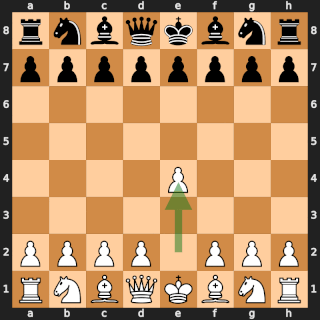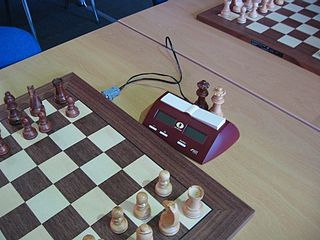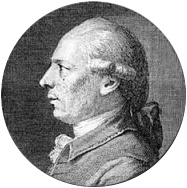Castling is a move in chess. It consists of moving the king two squares toward a rook on the same rank and then moving the rook to the square that the king passed over. Castling is permitted only if neither the king nor the rook has previously moved; the squares between the king and the rook are vacant; and the king does not leave, cross over, or finish on a square attacked by an enemy piece. Castling is the only move in chess in which two pieces are moved at once.

A chess problem, also called a chess composition, is a puzzle set by the composer using chess pieces on a chess board, which presents the solver with a particular task. For instance, a position may be given with the instruction that White is to move first, and checkmate Black in two moves against any possible defence. A chess problem fundamentally differs from over-the-board play in that the latter involves a struggle between Black and White, whereas the former involves a competition between the composer and the solver. Most positions which occur in a chess problem are 'unrealistic' in the sense that they are very unlikely to occur in over-the-board play. There is a good deal of specialized jargon used in connection with chess problems.
In the game of chess, perpetual check is a situation in which one player can force a draw by an unending series of checks. This typically arises when the player who is checking cannot deliver checkmate, and failing to continue the series of checks gives the opponent at least a chance to win. A draw by perpetual check is no longer one of the rules of chess; however, such a situation will eventually allow a draw claim by either threefold repetition or the fifty-move rule. Players usually agree to a draw long before that, however.
A Babson task is a directmate chess problem with the following properties:
- White has only one key, or first move, that forces checkmate in the stipulated number of moves.
- Black's defences include the promotion of a certain pawn to a queen, rook, bishop, or knight.
- If Black promotes, then the only way for White towards a forced checkmate in the stipulated number of moves is to promote a pawn to the same piece to which Black promoted.
This glossary of chess problems explains commonly used terms in chess problems, in alphabetical order. For a list of unorthodox pieces used in chess problems, see Fairy chess piece; for a list of terms used in chess is general, see Glossary of chess; for a list of chess-related games, see List of chess variants.
The Novotny is a device found in chess problems named after a problem from 1854 by Antonín Novotný, though the first example was composed by Henry Turton in 1851. A piece is sacrificed on a square where it could be taken by two different opposing pieces, but whichever makes the capture, it interferes with the other. It is essentially a Grimshaw brought about by a sacrifice on the critical square.
In the game of chess, an endgame study, or just study, is a composed position—that is, one that has been made up rather than played in an actual game—presented as a sort of puzzle, in which the aim of the solver is to find the essentially unique way for one side to win or draw, as stipulated, against any moves the other side plays. If the study does not end in the end of the game, then the game's eventual outcome should be obvious, and White can have a selection of many different moves. There is no limit to the number of moves which are allowed to achieve the win; this distinguishes studies from the genre of direct mate problems. Such problems also differ qualitatively from the very common genre of tactical puzzles based around the middlegame, often based on an actual game, where a decisive tactic must be found.
Stalemate is a situation in chess where the player whose turn it is to move is not in check and has no legal move. Stalemate results in a draw. During the endgame, stalemate is a resource that can enable the player with the inferior position to draw the game rather than lose. In more complex positions, stalemate is much rarer, usually taking the form of a swindle that succeeds only if the superior side is inattentive. Stalemate is also a common theme in endgame studies and other chess problems.
A helpmate is a type of chess problem in which both sides cooperate in order to achieve the goal of checkmating Black. In a helpmate in n moves, Black moves first, then White, each side moving n times, to culminate in White's nth move checkmating Black. Although the two sides cooperate, all moves must be legal according to the rules of chess.

The Opera Game was an 1858 chess game, played at an opera house in Paris. The American master Paul Morphy played against two strong amateurs: the German noble Karl II, Duke of Brunswick, and the French aristocrat Comte Isouard de Vauvenargues. It was played as a consultation game, with Duke Karl and Count Isouard jointly deciding each move for the black pieces, while Morphy controlled the white pieces by himself. The game was played in a box while an opera was performed on stage. Morphy quickly checkmated his opponents following rapid development of material, involving a queen sacrifice.

Checkmate is any game position in chess and other chess-like games in which a player's king is in check and there is no possible escape. Checkmating the opponent wins the game.
In chess, a back-rank checkmate is a checkmate delivered by a rook or queen along the opponent's back rank in which the mated king is unable to move up the board because the king is blocked by friendly pieces on the second rank.
In chess problems, retrograde analysis is a technique employed to determine which moves were played leading up to a given position. While this technique is rarely needed for solving ordinary chess problems, there is a whole subgenre of chess problems in which it is an important part; such problems are known as retros.
The Saavedra position is one of the best-known chess endgame studies. It is named after the Spanish priest Fernando Saavedra (1849–1922), who lived in Glasgow during the late 19th century. Though not a strong player, he spotted a win involving a dramatic underpromotion in a position previously thought to have been a draw.

In chess, promotion is the replacement of a pawn with a new piece when the pawn is moved to its last rank. The player replaces the pawn immediately with a queen, rook, bishop, or knight of the same color. The new piece does not have to be a previously captured piece. Promotion is mandatory when moving to the last rank; the pawn cannot remain as a pawn.

The Philidor position is a chess endgame involving a drawing technique for the defending side in the rook and pawn versus rook endgame. This technique is known as the third-rank defense due to the positioning of the defending rook. It was analyzed by François-André Danican Philidor in 1777. Many rook and pawn versus rook endgames reach either the drawn Philidor position or the winning Lucena position. The defending side should try to reach the Philidor position; the attacking side should try to reach the Lucena position. Said grandmaster Jesús de la Villa, "[The Lucena and Philidor positions] are the most important positions in this type of endgame [...] and in endgame theory."
Tsume shogi or tsume (詰め) is the Japanese term for a shogi miniature problem in which the goal is to checkmate the opponent's king. Tsume problems usually present a situation that might occur in a shogi game, and the solver must find out how to achieve checkmate. It is similar to a mate-in-n chess problem.

In chess, an endgame tablebase, or simply tablebase, is a computerised database containing precalculated evaluations of endgame positions. Tablebases are used to analyse finished games, as well as by chess engines to evaluate positions during play. Tablebases are typically exhaustive, covering every legal arrangement of a specific selection of pieces on the board, with both White and Black to move. For each position, the tablebase records the ultimate result of the game and the number of moves required to achieve that result, both assuming perfect play. Because every legal move in a covered position results in another covered position, the tablebase acts as an oracle that always provides the optimal move.
Omega Chess is a commercial chess variant designed and released in 1992 by Daniel MacDonald. The game is played on a 10×10 board with four extra squares, each added diagonally adjacent to the corner squares. The game is laid out like standard chess with the addition of a champion in each corner of the 10×10 board and a wizard in each new added corner square.

In chess, several checkmate patterns occur frequently enough to have acquired specific names in chess commentary. By definition, a checkmate pattern is a recognizable/particular/studied arrangements of pieces that delivers checkmate. The diagrams that follow show these checkmates with White checkmating Black.






